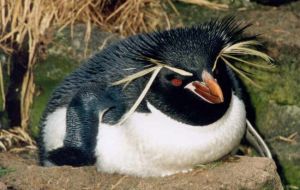MercoPress. South Atlantic News Agency
Magallanes Rockhopper population reaches 316 thousand
 Rockhopper penguins at Noir Island
Rockhopper penguins at Noir Island Scientists reported this week that the population of Southern Rockhopper penguins on Isla Noir, in southern Chile, the most important colony for the Eudyptes chrysocom family in all of South America, has risen to 316 thousand. Environmentalists stressed the importance of this increase in population, especially in light of the drop in the species' population in previous decades.
The overall decline of the world's penguin population began in the middle of the 19th century when the European whaling industry devastated the species by using their eggs and meat for food. In 1860 the reward for a captured penguin was so lucrative that in just three years hunters managed to kill around 500,000 penguins. Best known for their large, yellow crests, the Southern Rockhopper has been able to live on Isla Noir, Magallanes Region, close to Punta Arenas, in relative isolation due to the heavy rain and winds that are typical of the island. The penguins occupy a large area – 15 km long by 3 km wide – on the peripheries of the island's southern canals. This area is extremely conducive to their reproductive habits, as the penguins are known to nest in highly vegetated areas that are difficult to reach. Alejandro Kusch launched the first environmental study on the penguin's population at Isla Noir in 2003 with help from United States conservationists David Oehler, Scott Dresichman, and ornithologist Manuel Marin. The team, backed by a United States foundation Feather-Link, has tracked and followed the penguins by satellite in an effort to learn more about the habits of the species and the reason for the decreases in population. Current estimates report a population of 475,000 penguins throughout South America, concentrated mainly in Isla Noir and the South Atlantic's Falkland Islands. Environmental experts warn that the penguin population at Isla Noir may not continue to increase just because of the recent population boosts, noting that the island is still not a legally protected area. Environmentalists hope that a seven-year study now underway will provide enough information to put together an Isla Noir-specific handling and conservation plan for the penguins. Kusch hopes this study will result in converting the island into a "natural laboratory." The Santiago Times




Top Comments
Disclaimer & comment rulesCommenting for this story is now closed.
If you have a Facebook account, become a fan and comment on our Facebook Page!